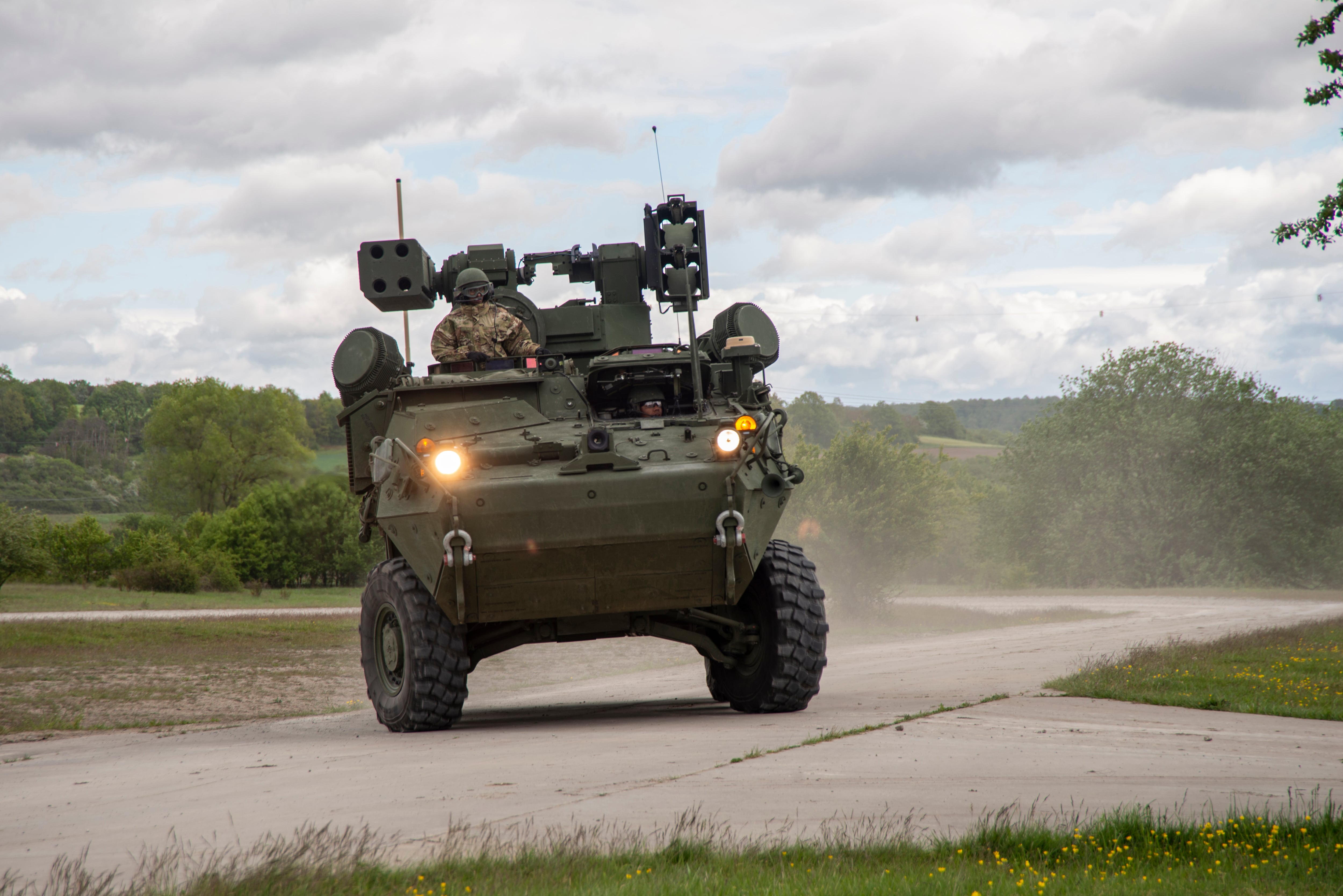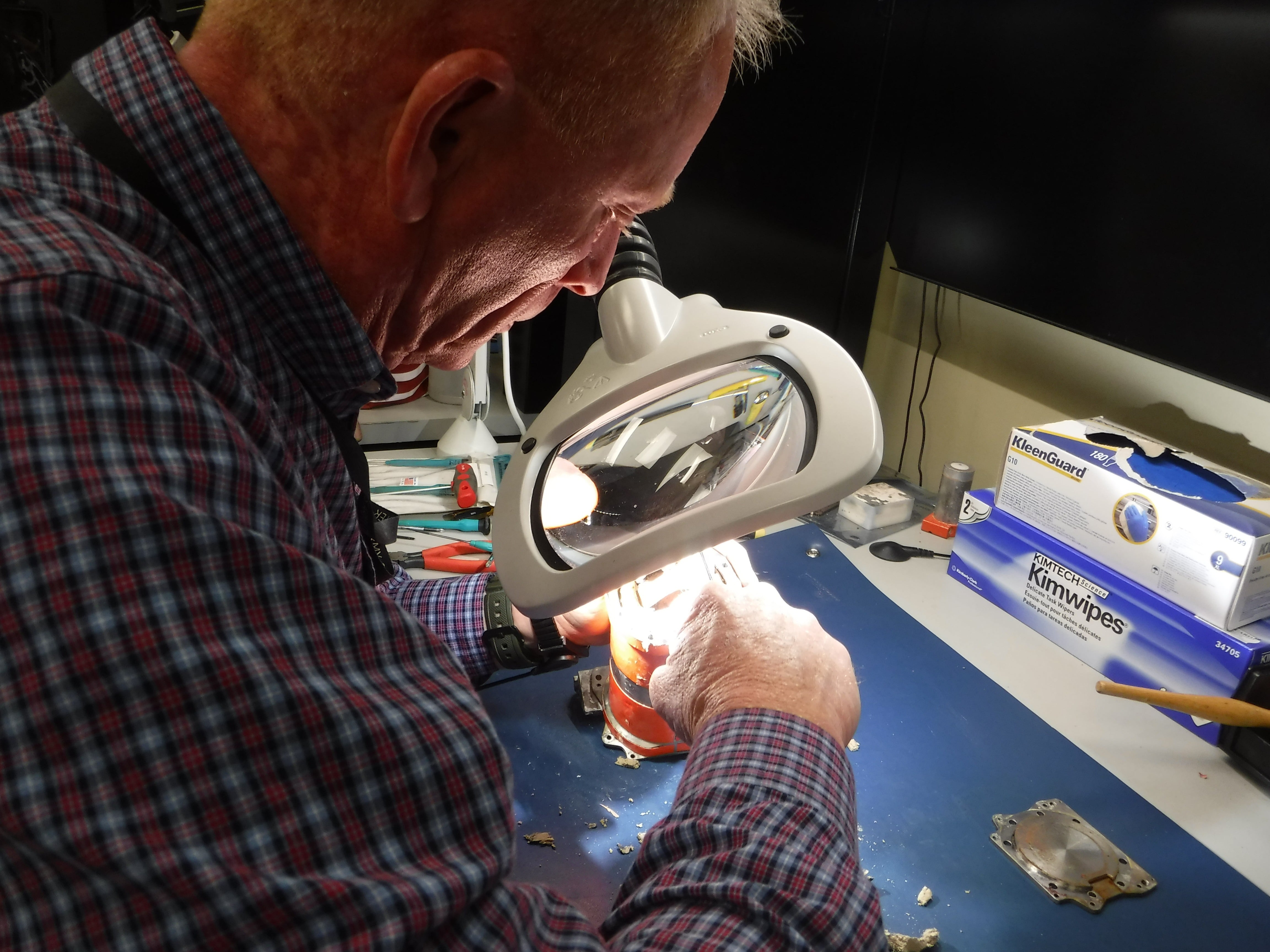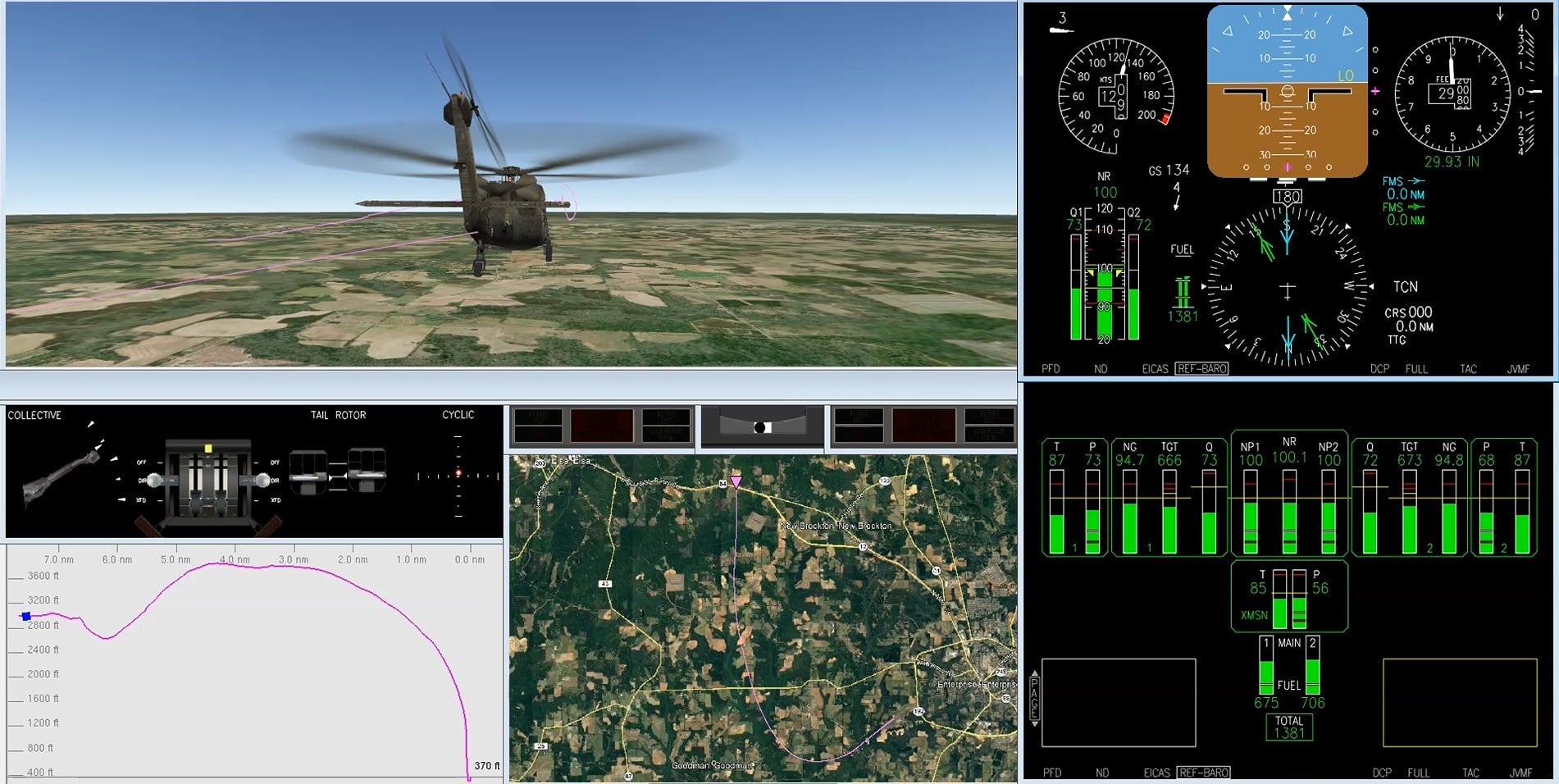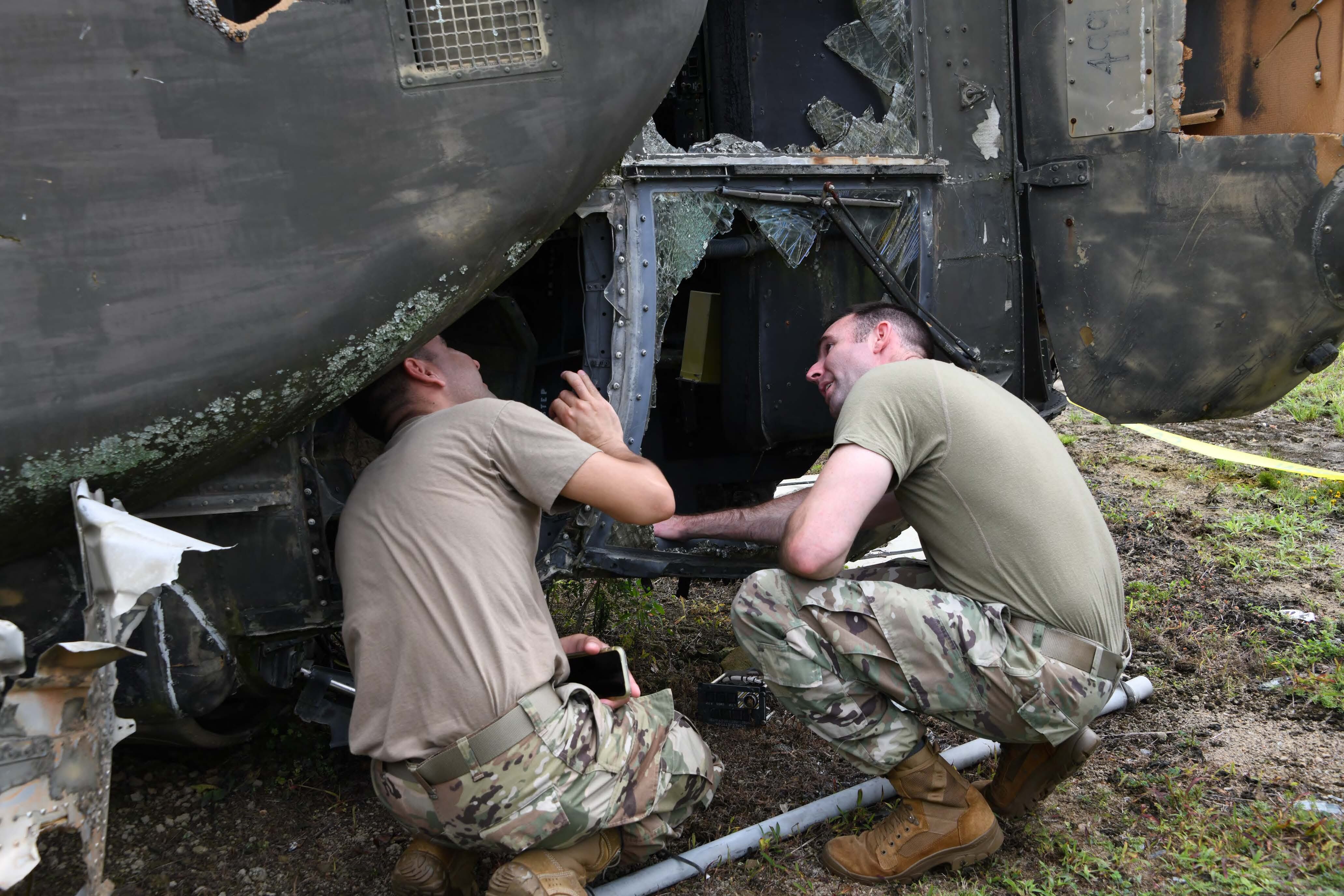FORT RUCKER, Ala. — Chief Warrant Officer 4 Mark Leung knows he has his work cut out for him every time he hits the road.
Leung is one of the Army’s top accident investigators, assigned to the service’s Combat Readiness Center at Fort Rucker. He’s been there for around four years and investigated at least a dozen accidents, by his count.
Each time, he’s an outsider, sent to scour every detail in search of how and why an accident unfolded. Though Leung’s an aviator by trade, he mostly presides over ground mishap investigations now. And each time, he has to present the investigation’s findings to a general who may not want to listen to a pilot.
“I absolutely have a chip on my shoulder when I walk in there, because 99% of the time, that general is not an aviator,” said Leung. “I have to go in there with my team that we’ve assembled with our [subject matter experts, and] I have to make sure that there are no holes in there.”
CRC sends accident investigation teams to probe virtually all of the service’s on-duty fatal accidents, as well as those that destroy aircraft. Army Times visited CRC headquarters and interviewed its senior leaders, accident investigators and data recovery experts to understand how the organization learns from deadly mishaps and communicates those lessons to the force.
Last year, CRC officials took pride in a record-low number of on-duty accidental deaths, but those numbers were undercut by a rise in off-duty deaths, and they’re rising again after a series of mishaps in recent months — tactical vehicle accidents, a bear attack and more. CRC officials spoke with Army Times in an effort to educate the force about their work, which includes a pending update to the driver training regulation, so that their lessons will stick.
By the time an investigator like Leung delivers the final findings and recommendations, experts from CRC and around the Army have completed a weeks- or months-long fact-finding process. Their probes involve dispatching a team and organizing the safety investigation board, examining the accident scene and conducting interviews, and analyzing the data and deliberating on their findings.
Looking for answers
During their investigations, CRC and other Army experts delve into human — both personal and systemic — factors, material factors and environmental factors that precede accidents.
CRC investigations are completely distinct from legal investigations, explained the center’s operations director Eric Schwegler. Some information found during accident investigations is considered completely private under safety privilege, which keeps even law enforcement from accessing witness interviews.
“If I can promise a [witness] that everything that they tell me will be protected, then they may not lawyer up on me,” said Schwegler. “They may tell me what happened, and sometimes they may be the only witness, whether they’re responsible for the [mishap] or just simply saw what happened.”
RELATED

While other components of safety investigations include tedious tasks like locating and analyzing each piece of a vehicle’s wreckage or poring through a unit’s training records and policy documents, a crucial part of many inquiries is the data from vehicles’ so-called “black boxes.” These are the infamous, if poorly-named, digital data and voice recorders that can tell the story of a crash even if there are no survivors.
“You media guys have to help us out,” joked Schwegler, gesturing to the orange-painted black boxes. “We continue to dwell upon the whole black box theory, and there are no black boxes.”
CRC has a dedicated laboratory for recovering data from these recorders, which are often severely damaged as a result of the accident.
The service’s senior-most digital collection analysis technician, Tim Ashcom, explained that these recorders capture thousands of data parameters up to 12 times per second, offering investigators a critical look at what equipment or human failures may have caused or contributed to an accident.
Sometimes Ashcom has to physically repair data terminals and other components of the recorders to successfully recover the data.
“[If] it was submerged in water or in the area of fire or heat damage, that adds additional days to the [download] process,” Ashcom told Army Times. “Just imagine an auto mechanic and a surgeon. At this level here, we have to get to data recovery on the circuitry — you’re talking about the work of a surgeon.”

For aviation mishaps and crashes, the analysis lab then takes that data and combines it with other information gathered by investigators to produce an animation of the event at the unit’s request.
The animations show a 3D model of the airframe over a simulated version of the local terrain alongside panels displaying the altitude, the flight path and the instruments and controls as they appeared to the pilots.
CRC also adds in the audio from the cockpit voice recorder and synchronizes it with the animation, offering investigators the closest thing possible to experiencing the moments before the accident as the pilots did.
The aviation animations also play a key role in helping units learn lessons from accidents, particularly when they depict aviators who correctly applied emergency procedures and were able to save their aircraft — and their lives.
“[The animations] are not always trying to figure out a smoking hole,” said Schwegler, the CRC’s director of operations. “It’s [about] our ability to take data from these aircraft and turn it into lessons and examples of what right looks like so that we can continue to train the force in a broader perspective.”
Recreating the mishap
CRC officials released one such animation to Army Times that recreated a UH-60 Black Hawk’s harrowing training flight one day at the south Alabama base.
The pilots, a flight student and a more experienced instructor pilot, were on a routine flight when they had a key engine component fail, making the helicopter’s rotor begin to rotate at an uncontrollable speed.
As the instructor pilot realized the enormity of the failure, he began talking the student through emergency procedures while coordinating for an emergency landing.
“Don’t put it to idle. Fuck!” said the senior pilot. “Shit…mayday, mayday, mayday.”
After regaining control of the stricken aircraft and landing on the airfield, the two expressed their relief — “Jesus Christ,” said the student, to which the instructor responded, “Holy shitballs, dude.”
Profanity aside, said Schwegler, this particular animation is now a “training aid” at Fort Rucker’s flight school.
“It’s a great example of flying the aircraft, diagnosing the problems, doing emergency procedures, coordinating inside the aircraft with the crew, and landing the aircraft — and they all walked away from it,” Schwegler said.

Not all incidents end well, though, and the animations can be a haunting but powerful investigative aide.
What the investigations often reveal, said CRC director Brig. Gen. Andrew Hilmes, is “that just about everything we see is human error. On the aviation side, it’s 86% human error [and] on the ground side, it’s [about] 100%.”
In many of those cases, Hilmes explained, systemic factors also play a role in the tragedy. And that’s where CRC’s recommendations come into play. Each mishap investigation can lead to systemic recommendations as simple as improving signage on a dangerous tank trail or as complex as Army-wide policy changes.
Hilmes explained that CRC shared many of its takeaways from tactical vehicle rollover accidents with the Government Accountability Office as the watchdog prepared their landmark report blasting the Army and Marine Corps’ efforts to prevent such tragedies.
“It’s going to drive some change that’s much needed,” said Hilmes. “[It] really resonated with both the Army and the Marine Corps…it told us what we needed to hear.”
One major shift coming is a total overhaul of how the service does driver training for tactical ground vehicles. The general has been part of a Pentagon working group that’s hoping to roll out the new program to the force in early-to-mid 2023.
The old decentralized driver training program was prone to “pencil-whipping” and was rarely conducted to standard. Hilmes said that will change — the new program is “going to be a lot more prescriptive.”
He said drivers will likely train on task-driven progressions for each vehicle, attaining different levels of driving certification over time with continuous training and the accumulation of accident-free miles behind the wheel.
Hilmes is hopeful that the new program will help units realize that they can’t deprioritize driver training.
“We haven’t investigated a tactical vehicle accident [since 2019]...where [the unit] had a to-standard driver’s training program. It is a problem,” he said. “It’s not sexy. But, man, it’s foundational.”
Ground versus air
CRC officials repeatedly emphasized the gulf between how ground units and aviation units approach safety — it’s a matter of both culture and resources, they explained.
Aviation units have dedicated full-time safety officers at the company level, explained Dana Probert, who oversees CRC’s training and education directorate.
But non-aviation units don’t. They primarily only have part-time additional duty safety officers and NCOs at the company and battalion levels, and most full-time brigade safety officers are Army civilians rather than soldiers.
CRC investigator Chief Warrant Officer 4 Salem St. James said that “if people keep treating your safety program like it’s an additional duty, that’s all it’s ever going to be.”
She noted that other branches of the military have entire career fields dedicated to training drivers and upholding safety standards, but acknowledged that the Army can’t “pull time, money and people out of the sky.” But if the service could, she thinks that having dedicated ground safety personnel at the battalion or company level would help better safety practices reach troops that need them.

St. James added that, in her experience, aviation units want rigorous CRC investigations whenever accidents occur.
“They want to know where there’s holes in their swing,” St. James said.
Leung, a fellow investigator with experience on ground and aviation accident inquiries, said that he sees accident prevention and safety culture as “a bit more ingrained in the aviation [community],” possibly due to the higher number of dedicated safety officers.
“These aviation commanders have grown up with risk management beaten into their heads from when they were lieutenants and [from] always having someone right there the whole time as a safety professional,” said Leung. “Whereas when [a ground officer is] a brigade commander, it’s the first time they’re really having a safety professional in their hip pocket.”
The center’s operations director, Eric Schwegler, explained that the “math” on increasing the number of positions dedicated to ground safety has been done before. But whenever the service creates a new career field, it has to take funding and authorizations from another one.
“It really comes down to…what do you want [the Army] not to do for the benefit of having this,” he said. “Would it help? Absolutely. Would it be costly? Yes…if we could ever get that implemented, we would be a safer Army.”
Hilmes, the CRC commander, agreed, but added that risk management is a “commander’s business” at the end of the day.
“I would always welcome more full-time safety officers…[and] we’ve determined what the [resource] requirement is,” explained Hilmes. “We have the answers to the test. It’s just [that] we don’t have enough people using the answer key we’re giving them.”
Davis Winkie covers the Army for Military Times. He studied history at Vanderbilt and UNC-Chapel Hill, and served five years in the Army Guard. His investigations earned the Society of Professional Journalists' 2023 Sunshine Award and consecutive Military Reporters and Editors honors, among others. Davis was also a 2022 Livingston Awards finalist.





